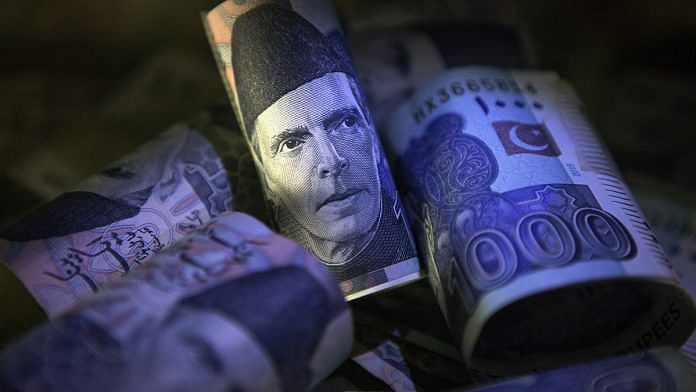Karachi: Pakistan’s rupee is vying for the title of the world’s biggest loser this month, the victim of an apparent devaluation with more pain ahead.
The managed-float currency dropped more than 5% in May and breached 150 per dollar, after the government agreed to another bailout by the International Monetary Fund that recommended a market-determined exchange rate. The central bank had devalued the currency five times last year.
“This knee-jerk reaction of the market will continue,” said Kaiser Bengali, an economist who has helped previous governments in multiple roles including as the designer and first head of the cash-based social support program in 2008. “Given our large deficit and high debt ratio, the rupee will continue to decline. The rupee will be 200 a dollar by year-end.”
Pakistan’s economy is going through a familiar boom-and-bust cycle; debt is soaring, inflation is rocketing, and reserves are falling after a deficit blowout. The IMF has long advocated Pakistan to loosen its grip on the rupee, and estimated the real exchange rate was overvalued by as much as 20% in 2017.
The central bank did not immediately respond to a request for a comment on the rupee’s performance. Earlier this month, it said the rupee level reflects demand and supply conditions in the foreign-exchange market, and that it will help in correcting market imbalances.
Also read: Imran Khan can sell buffaloes and choppers, but Pakistan’s economy is still crashing
Record Low
The rupee closed at 149.64 per dollar on Wednesday, according to the central bank. It touched a record-low 152.525 last week, according to data compiled by Bloomberg, and is among the worst performers globally in May together with currencies from Zambia and Haiti. The rupee has now erased almost a third of its value in the past 12 months.
The central bank still intervenes but the currency is now more determined by market forces, according to three foreign-exchange dealers who requested not to be named since they are not allowed to speak publicly.
Here are other comments on the rupee:
Uzair Younus, South Asia director at Washington-based consultancy Albright Stonebridge Group LLC
“It seems that the rupee’s value is still being managed, but the State Bank of Pakistan is not allowing imbalances to build up. The decision has been made to not allow the currency to remain overvalued for a long period of time.” “I expect the central bank to be measured in its approach and intervene only when it’s absolutely necessary. The pressure on the rupee will continue and the central bank will allow it to depreciate further in the coming weeks.”
Ahmed Ateeq, head of treasury at Pak Brunei Investment Co. in Karachi
The dollar/rupee is at a realistic level for the first time in two years “We are close to real effective exchange rate” that is a benchmark used by the IMF The rupee will hover around 150 for now but we may see a 5%-6% drop by year-end that is normal for a nation like Pakistan.
Shahid Ali Habib, chief executive officer at Arif Habib Ltd. in Karachi
Rupee is “very much fairly valued” so it is unlikely to see further devaluation The currency will be more market driven, so there may be a bit more volatility on demand and supply though it will stay near this level “When you go into IMF program, the central bank does not deploy its reserves to manage the currency. They will intervene to stop any speculation.”
Also read: Currency, forex, growth in free fall: Economy is Pakistan’s real crisis, IMF only saviour






